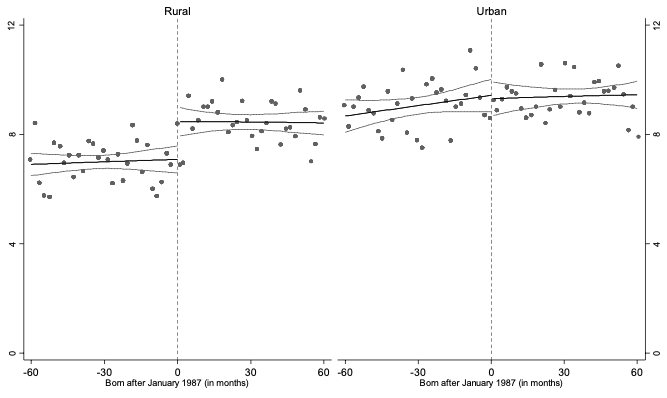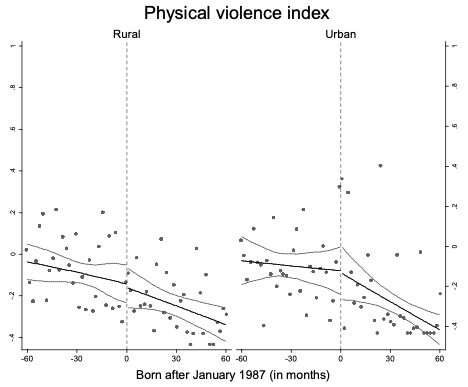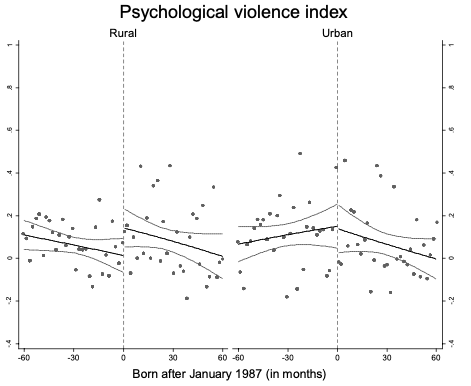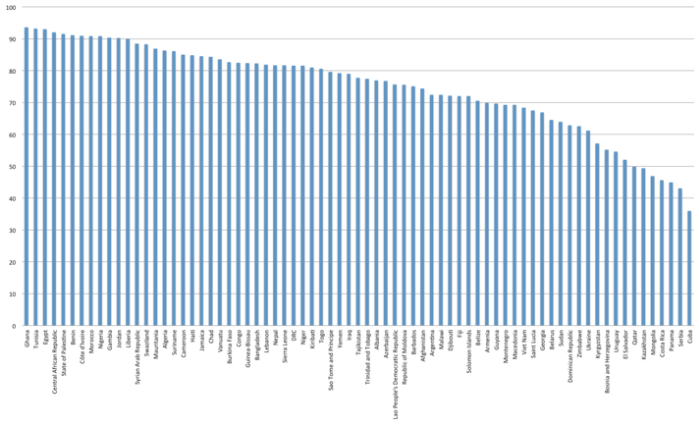
Increased schooling for girls in Turkey led to a rise in psychological violence, but also reduced the intergenerational transmission of violence
Domestic violence remains a widespread problem with adverse health and economic consequences across the world. During their lifetime, approximately 30% of women aged 15 and older experience physical or sexual violence from their partners, and this prevalence is even higher in developing countries (World Health Organisation 2013). Women in violent relationships are more likely to report physical, mental, and reproductive health problems, and their children are more likely to suffer from socio-emotional and cognitive problems. In the US alone, the lifetime economic costs of intimate partner violence amount to $3.6 trillion, with $1.3 trillion attributed to productivity losses (Peterson et al. 2018).
Although many observers consider the economic empowerment of women as a major tool in the fight against domestic violence, the impact of female economic empowerment on the risk of experiencing domestic violence is hard to predict. On the one hand, female empowerment through employment opportunities and income transfers may reduce their exposure to violence by improving their bargaining power in the relationship. On the other hand, an increase in women’s resources may increase the risk of domestic violence if men use violence or threats of violence as instruments to control these newly obtained resources.
In our recent research, we focus on the effect of a specific empowerment channel – education – on the prevalence of domestic violence in Turkey (Erten and Keskin 2018). Our findings reveal that while increased female schooling improved women’s labour market outcomes, this economic empowerment did not translate into empowerment within households. The increase in education, particularly among rural women, led to an increase in self-reported psychological violence and financial control behaviour, without changes in physical violence, partner characteristics, or women’s attitudes towards such violence. However, related evidence shows that increased female education significantly reduced the intergenerational transmission of violence by decreasing child physical maltreatment by mothers who experienced violence from their own parents (Erten and Keskin 2019).
Increase in female education through the Basic Education Programme in Turkey
In 1997, Turkey implemented a new education policy – the Basic Education Programme (BEP) – by increasing compulsory schooling from five to eight years. The BEP applied to all students who did not already have a primary school diploma at the beginning of the 1997-1998 school year. Given that the required age for beginning junior high school in Turkey is 12, the expansion of compulsory schooling in 1998 implied that individuals born before January 1987 could drop out after five years, whereas those born after January 1987 had to complete eight years of education.
Using this exogenous change in compulsory schooling policy, we examine the effects of the education reform on years of schooling completed. The comparison of those affected by the education reform to those that are not affected within a narrow age range allows us to capture the increase in education holding unobservables such as ability, discount rates, and upbringing – all of which may affect both education and domestic violence risk – constant.
Our findings indicate that the reform had no significant effect on men, most of whom were already completing eight years of schooling when the reform was implemented. However, we find that the reform significantly increased educational attainment of women. As shown in Figure 1, the main compliers with the reform were women raised in rural regions of Turkey. Our estimates show that the reform increased the schooling of rural women by about 1.8 years and junior high school completion by 34 percentage points.
Figure 1 The effects of the education reform on women’s years of schooling by childhood region

Female education increased psychological violence and financial control behaviour
Examining whether exposure to the compulsory schooling law changed the risk of domestic violence, Figure 2 shows that in fact women raised in rural regions and exposed to the reform, experienced an increase in psychological violence and financial control behaviour exercised by their male partners. On the other hand, we find no evidence of a significant change in physical or sexual violence experienced by women.
This evidence raises the question of which channels could potentially explain this adverse effect of education on domestic violence. In an exploration of potential mechanisms, we find that the reform led to an improvement in labour market outcomes of women, as they were more likely to be employed, particularly in the service sector, have social security benefits, and earn a personal income. On the other hand, our findings indicate that the reform did not significantly affect women’s attitudes, marriage market outcomes, or their partners’ characteristics. This evidence is consistent with the instrumental theories of violence that predict an increase in risk of domestic violence in response to a rise in women’s income to the extent that this may increase the incentives of men to use violence as a means of rent extraction from their partners.
Figure 2 Effects of the education reform on physical and psychological violence


The reduction in intergenerational transmission of violence
A related question that we explored in a subsequent study has been whether education can break the cycle of violence by reducing the intergenerational transmission of violence (Erten and Keskin 2019). The cycle of violence – the propensity of parents who were exposed to physical maltreatment in their childhood to maltreat their own children – is a pervasive social problem across the world. Figure 3 shows that eight of 10 children aged two to 14 years are routinely subjected to violence at home in developing countries. Given that even mild forms of violence can have serious economic and public health consequences, it is important to consider whether education of mothers can be an effective means of breaking the cycle of violence.
Using the same exogenous variation from the 1997 BEP, we examine whether exposure to increased schooling reduce the incidence of physical maltreatment of mothers towards their children. Our findings indicate that the increase in education among rural women led to a reduction in the perpetration of child physical abuse but only by mothers who were physically abused by their own families during childhood. This evidence implies that in fact education has been effective in reducing the intergenerational transmission of violence. The underlying channel we document is that these high-risk women were more likely to experience improved mental health outcomes as a result of attending school for a longer period of time.
Figure 3 Percentage of children aged 2 to 14 years who experienced any violent discipline (psychological aggression and/or physical punishment) in the past month

Concluding remarks
Our analysis shows that the expansion of compulsory schooling in Turkey had significant empowerment effects on women through the labour market channel. However, this economic empowerment created backlash effects by triggering more domestic violence. On the bright side, increasing maternal education has improved the mental health of mothers, who were at risk of physically abusing their children due to their own childhood experiences. Hence, the evidence implies a mixed view of effectiveness of educational reforms for overall well-being of women and children in a context with relatively low levels of female empowerment along several dimensions.
References
Erten, B and P Keskin (2018), “For better or for worse? Education and the prevalence of domestic violence in Turkey”, American Economic Journal: Applied Economics 10(1): 64-105.
Erten, B and P Keskin (2019), “Breaking the cycle? Education and the intergenerational transmission of violence”, Accepted at the Review of Economics and Statistics.
Peterson, C, M Kearns, W McIntosh, L Estefan, C Nicolaidis, K McCollister, A Gordon and C Florence (2018), “Lifetime economic burden of intimate partner violence among US adults,” American Journal of Preventive Medicine 55(4): 433-444.
World Health Organisation (2013), Global and regional estimates of violence against women: Prevalence and health effects of intimate partner violence and non-partner sexual violence. .

